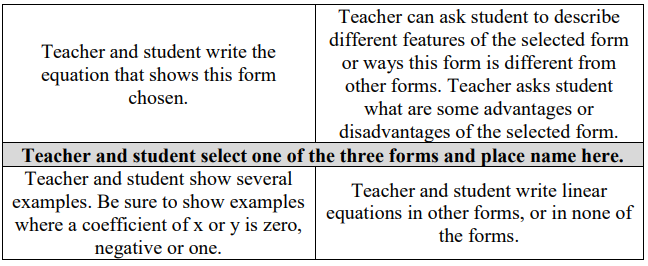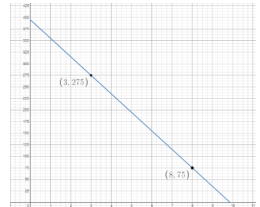General Information
Benchmark Instructional Guide
Connecting Benchmarks/Horizontal Alignment
Terms from the K-12 Glossary
- Domain
- Intercept
- Range
- Slope
Vertical Alignment
Previous Benchmarks
Next Benchmarks
Purpose and Instructional Strategies
In grade 8, students interpreted the slope and -intercept of a linear equation in two variables. In Algebra I, students compare key features of two or more linear functions. In later courses, students will compare key features of linear and nonlinear functions.- Instruction includes the use of various forms of linear equations. Additionally, linear
functions can be represented as a table of values or graphically.
- Standard Form
Can be described by the equation + = , where , and are any rational number. - Slope-Intercept Form
Can be described by the equation = + , where is the slope and is the -intercept. - Point-Slope Form
Can be described by the equation − 1 = ( − 1), where (1, 1) are a point on the line and is the slope of the line.
- Standard Form
- Problem types include comparing linear functions presented in similar forms and in different forms, and comparing more than two linear functions.
- Instruction includes representing domain and range using words, inequality notation and
set-builder notation.
- Words
If the domain is all real numbers, it can be written as “all real numbers” or “any value of , such that is a real number.” - Inequality notation
If the domain is all values of greater than 2, it can be represented as > 2. - Set-builder notation
If the domain is all values of less than or equal to zero, it can be represented as {| ≤ 0} and is read as “all values of such that is less than or equal to zero.”
- Words
Common Misconceptions or Errors
- When describing domain or range, students may assign their constraints to the incorrect variable. In these cases, ask reflective questions to help students examine the meaning of the domain and range in the problem.
- Students may also miss the need for compound inequalities when describing domain or range. In these cases, use a graph of the function to point out areas of their constraint that would not make sense in context.
Strategies to Support Tiered Instruction
- Teacher provides a laminated cue card to aid in the identification of domain and range
restrictions:
- Is the constraint on the independent or dependent variable in the context of the problem?
- Does the constraint restrict the input or output value in the context of the problem?
- Was the constraint shown or highlighted on the - or -axis?
- Teacher provides a chart to show different terminology associated with domain and range.

- Instruction includes opportunities to use a graphic organizer to chart and provide specific
examples of domain and range as compound inequalities.

- Teacher provides a graphic organizer for each of the three forms of linear equations (standard, slope-intercept and point-slope form) that can be co-created to highlight key similarities and differences.

Instructional Tasks
Instructional Task 1 (MTR.2.1, MTR.5.1)- Callie and her friend Elena are reading through different novels they checked out from their school library last Tuesday. Callie’s progress through her novel can be modeled by the function () = −25 + 318, where () represents the number of pages remaining to be read and is the number of days since receiving the book. Elena’s progress through her novel is modeled by the graph below.

- Part A. Which student’s novel has more pages to read?
- Part B. Assuming they both continue to read at a constant rate, which student will complete their novel first?
Instructional Items
Instructional Item 1- Two linear functions, () and (), are represented below. Compare the functions by
stating which has a greater -intercept, -intercept and rate of change.

*The strategies, tasks and items included in the B1G-M are examples and should not be considered comprehensive.
